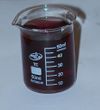Potassium ferrate
| |||
| Names | |||
|---|---|---|---|
| IUPAC name
Potassium ferrate
| |||
| Systematic IUPAC name
Potassium ferrate (VI) | |||
| Properties | |||
| K2FeO4 | |||
| Molar mass | 198.04 | ||
| Appearance | Dark purple crystals | ||
| Odor | None | ||
| Density | 2.829 | ||
| Melting point | 198 °C (388 °F; 471 K) decomposes | ||
| Soluble (slowly decomposes unless pH is high) | |||
| Solubility in ethanol | Insoluble (0 °C and below) Reacts with solvent (20 °C) | ||
| Related compounds | |||
| Related ferrates
|
barium ferrate sodium ferrate | ||
| Except where otherwise noted, data are given for materials in their standard state (at 25 °C [77 °F], 100 kPa). | |||
| Infobox references | |||
Potassium ferrate is a compound with a formula of K2FeO4. This is an unstable potassium salt of ferric acid, which itself is too unstable to exist in aqueous solution. It is a dark purple crystalline solid that dissolves to form a reddish-purple solution. This solution is stable at high pH, but at neutral or lower pH, the ferrate decomposes, liberating oxygen.
Potassium ferrate is a very strong, but relatively mild oxidizer.
Contents
Properties
Physical
It is a dark purple crystalline solid that dissolves to form a reddish-purple solution which tends to "fizz" if hot and/or not pure enough. Its solubility in water is limited, which makes potassium ferrate the most practical ferrate: it is soluble in water, unlike the insoluble barium ferrate, but relatively easy to crystallize out of the solution, unlike the very soluble sodium ferrate which is particularly hard to isolate as a solid salt.
Chemical
It is a very potent oxidizer. It oxidizes primary alcohols to carboxylic acids, carboxylic acids to carbon dioxide and water, chlorates to perchlorates, ammonia to nitrogen, nitrites and nitrates. It is not known whether it is capable of oxidizing bromate to perbromate.
At high pH, the oxidizing strength of ferrate is relatively low, and the ferrate itself can be prepared with weaker oxidizers such as hypochlorites and bromine. At low pH, the full oxidizing power of ferrate is revealed.
Ferric acid, of which it is a salt, is a mid-strength acid, between hydrofluoric and formic in pKa. However, since it immediately decomposes on formation, any acidic compound, including carbon dioxide in the air, displaces ferric acid from its salt according to Le Chatelier's principle. Thus, potassium ferrate, itself a slightly basic compound, reacts with all acids, evolving oxygen and precipitating iron (III) oxide or hydroxide. Reactions in solution with strong acids like sulfuric acid are very vigorous, ferrate decomposes with much heat, and oxygen evolves in a quick "sneeze" that may result in spraying and splattering of the solution. If stabilizing alkali (KOH) is also present in solution, its neutralization further adds to the exothermicity of the reaction.
Potassium ferrate slowly decomposes in water, slower if it's cold and more alkaline and the ferrate is of higher grade, faster if it's hot and more acidic, and the ferrate is of lower grade. The solution evolves oxygen, which gives it the characteristic "ferrate fizz".
Availability
There is a growing market for potassium ferrate as a practical and ecologically friendly water purificant. As such, it can be bought from certain companies.
Preparation
There are several methods of ferrate synthesis. The most practical are the electrolytic method and the hypochlorite method. In the electrolytic method, a solution of potassium hydroxide is electrolyzed with iron electrodes. In the hypochlorite method, hydroxide or salts of trivalent iron are oxidized with hypochlorites in solution. Here is an example reaction:
2Fe(OH)3 + 3NaClO + 4KOH -> 2K2FeO4 + 3NaCl + 5H2O
In this method, a goop of freshly prepared iron (III) hydroxide is dissolved in a mixture of sodium hypochlorite and potassium hydroxide, with KOH in a large excess. The suspension quickly turns from brown to dark reddish-purple and clears out a bit, with the resulting ferrate dissolving.
In any case, preparing a solution of potassium ferrate isn't very hard, but crystallization of the stable pure salt is. It cannot be crystallized by evaporating the solution, because this provokes it to decompose, but it can be displaced from the solution by adding excess KOH. The trick is to quickly crystallize the ferrate, filter, dissolve in a weak solution of potassium hydroxide, recrystallize by adding a lot more hydroxide, filter and dry very quickly, because the impure compound decomposes on the fly. Vacuum filtering through sintered glass is mandatory, because ferrate oxidizes filter paper. Ice-cold anhydrous ethanol or diethyl ether is recommended for washing the crystals.
Before you experiment with this salt, stock up on KOH! All methods of ferrate synthesis tend to gobble this alkali like popcorn.
Handling
Safety
Potassium ferrate is non-toxic. The products of its decomposition aren't toxic either. However, dry potassium ferrate should not come in contact with flammable organic compounds. There were reports of warm ethanol catching fire on contact with potassium ferrate.
Storage
Potassium ferrate should be stored in a dark place, without access to air (it reacts with carbon dioxide in the air). Ideally, it should be kept under vacuum or inert gas.
Disposal
Potassium ferrate solutions can just be poured into the ground or drain. Contact with any organics causes the ferrate to be quickly reduced and decomposed.

